After last fall’s Amazon hardware event, which brought us a handful of new Echo devices, like the Dot with the clock and other minor updates, Amazon today is rolling out a broader refresh of its Echo lineup, which includes a new form factor with the arrival of the Echo Pop. While the current Dot is more of a rounded, bubble-shaped Echo, the Pop is a semi-circle and comes in teen-friendly colors like lavender and teal, while also serving to extend your home’s Wi-Fi network thanks to eero.
Alongside the launch, Amazon also unveiled other updated Echo devices, including the Echo Show 5, Echo Buds and Echo Auto, and offered more context about how it sees AI impacting Alexa’s future.
Until recently, Alexa’s future was seemingly uncertain, given reports of the billions of dollars the division has lost, its failures to inspire voice shopping and, later, the larger cost-cutting measures at the retail giant, which included layoffs in Amazon’s devices group.
However, SVP of Alexa Rohit Prasad downplays the impact those cuts had on Alexa, telling TechCrunch that of the 2,000 people let go within Amazon’s Devices and Services organization, only “a fraction of those were in Alexa,” he says. “Contrary to some of the things written, it was very small in context,” Prasad argues. “In terms of our roadmap and our conviction, Alexa is one of the biggest investments at Amazon and our conviction has only grown — especially in this time of how exciting AI is and what can be a quantitatively different, better, and more useful Alexa for our customers.”
Or, reading between the lines, Alexa’s AI potential outpaces that of the devices where it currently lives, like the Echo speakers, given its ability to extend its learnings elsewhere inside Amazon.
“I’m very optimistic that…the AI advances will be massive, but we are actually contributing to the Amazon businesses,” Prasad adds. “And I believe that Alexa is well on its trajectory to be that personal AI — which will also be a successful business for us.”
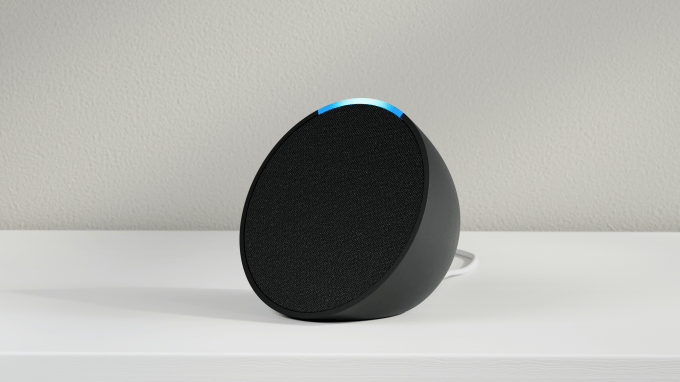
Image Credits: Amazon
As for the products themselves, the new $39.99 Echo Pop, which could seemingly eat into the Dot’s market share, has a front-facing directional speaker and is powered by the Amazon AZ2 Neural Edge processor. It also comes with eero Built-in, allowing the device to add up to 1,000 square feet of coverage to an existing eero Wi-Fi network, giving the device a dual purpose.
In addition to “Lavender Bloom” and “Midnight Teal,” the Pop comes in black and white.
Amazon says the Pop is in addition to, and not a replacement for, its existing Dot lineup, and the Dot and Dot with Clock remain available.
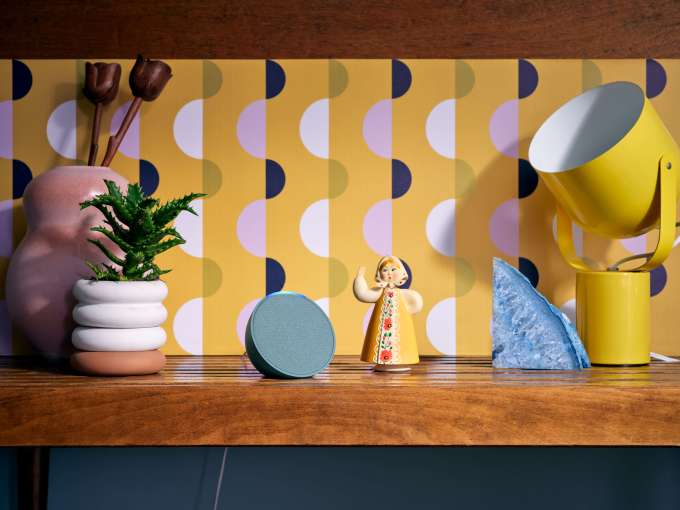
Image Credits: Amazon
Meanwhile, the $89.99 Echo Show 5 and $99.99 Echo Show 5 Kids edition both got an upgrade that makes them now 20% faster than the prior generation. Both also include a re-engineered microphone array, a faster AZ2 Neural Edge processor and an upgraded speaker system that promises a doubling of the bass and clearer sound.
And they now support the new smart home standard Matter, as does the new Echo Pop.
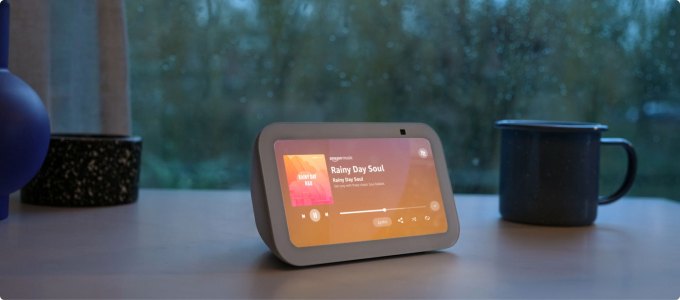
Image Credits: Amazon
The kids’ device — available in the U.S., U.K. and Germany — is slightly more expensive as it includes a year of the subscription service Amazon Kids+, offering ad-free and age-appropriate apps, games, Alexa skills and audiobooks, plus other kid-friendly features like the AI-powered story making tool, Create with Alexa. The latter has two new themes: Dinosaurs and Jazzy Jungle.
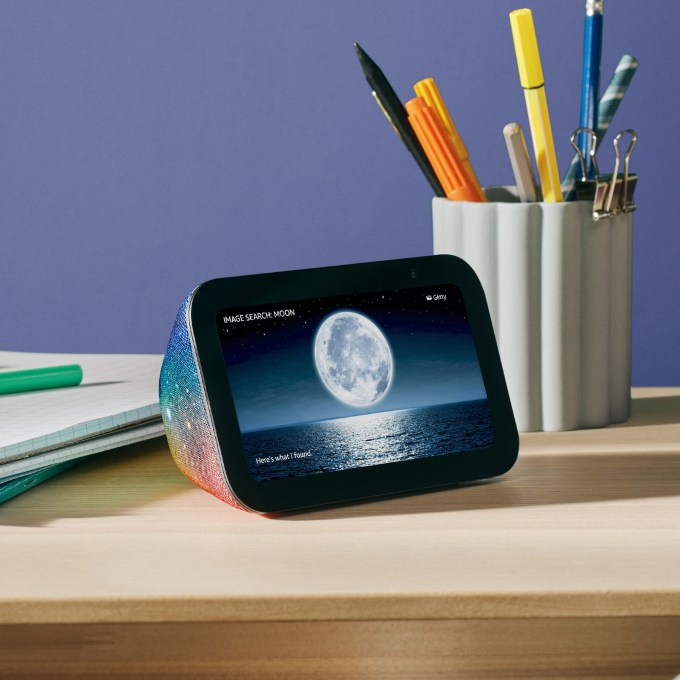
Image Credits: Amazon
Amazon’s $49.99 Alexa earbuds, Echo Buds, are also being updated with richer sound via a 12mm dynamic driver, improved clarity and a longer-lasting battery.
The new Buds get up to five hours of continuous playback, and up to 20 total hours of listening from a full case charge — the latter is up from 15 hours, in the prior generation. The earbuds also feature two microphones and a voice detection accelerometer, customizable tap controls, a VIP filter and multipoint pairing.
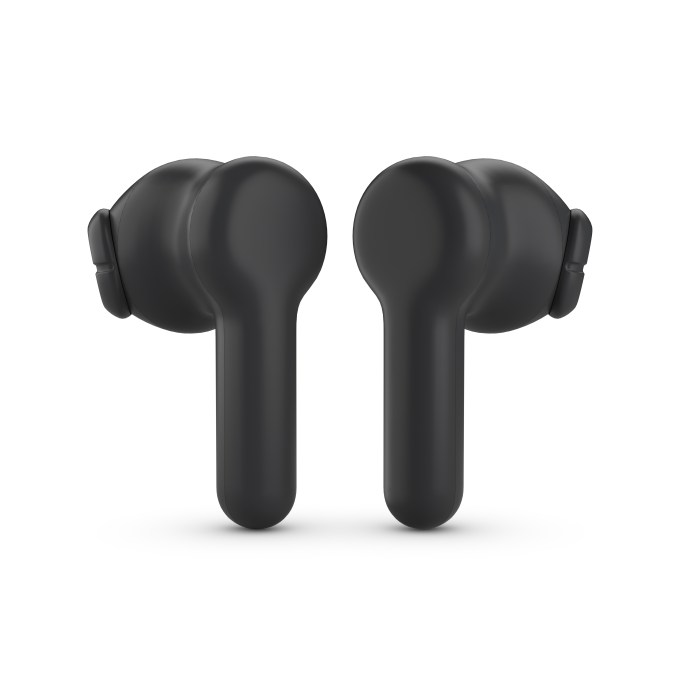
Image Credits: Amazon
The existing Echo Auto for vehicles is also now being made available to customers in Australia, Canada, the United Kingdom, Germany, France, Italy, Spain and Japan.
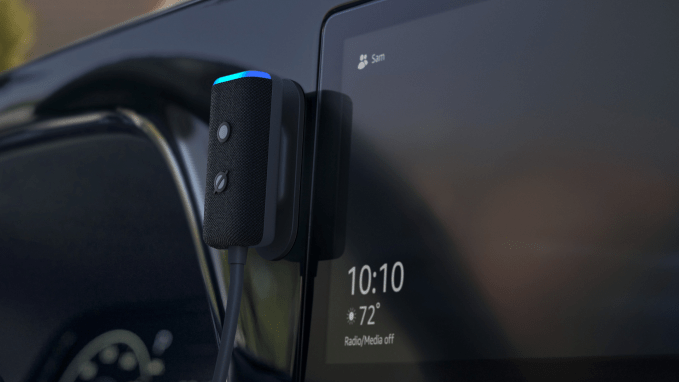
Image Credits: Amazon
As for Alexa, Amazon previously shared some of its thoughts about its smart assistant’s future during last month’s first-quarter earnings call with investors. Here, CEO Andy Jassy spoke of the company’s work to build a more “generalized and capable” large language model (LLM) to power Alexa and said the new LLM would help Amazon work toward its goal of building the best personal assistant — not just a smart speaker.
Already, many of Alexa’s experiences have been powered by a large 20 billion-parameter language model with encoder-decoder architecture, which it says is the biggest encoder-decoder model ever built. And with the introduction of Transformer-based large-scale multilingual models, the Alexa Teacher Model (or AlexaTM as it’s called) can transfer what it knows to another language without human supervision, helping Alexa get smarter, faster. The model is also used in conversational skills like Create with Alexa, where kids and Alexa come up with stories together.
Still, despite these AI advances, most customers are still using their Echo devices for basic tasks, like controlling their smart home or getting updates about their Amazon orders. Though sales of Alexa-enabled devices have now topped 500 million, they haven’t helped Amazon sell more merchandise, reports found. But Prasad says Alexa usage is still growing, with Alexa interactions up 35% year-over-year. People using the assistant to get information is up by more than 50% year-over-year, he notes.
As for what comes next, the exec only offers the broadest of hints.
The goal, he says, is for Alexa to provide better answers, but also those that are grounded in facts — a concern with modern AI. Plus, Alexa’s answers should be personalized to the end user. For example, if you told Alexa you felt hot, it should offer to turn your thermostat down, not suggest you go to the beach to cool off.
“We already have announced the Bedrock service which is for enterprise use cases,” Prasad says, referring to AWS’ new tools for building with generative AI. “And then, for Alexa — for the consumer use cases, like powering all the conversational experiences on Alexa — you’ll find qualitatively different elements of experiences that we’ll be launching along the year,” he teases.
